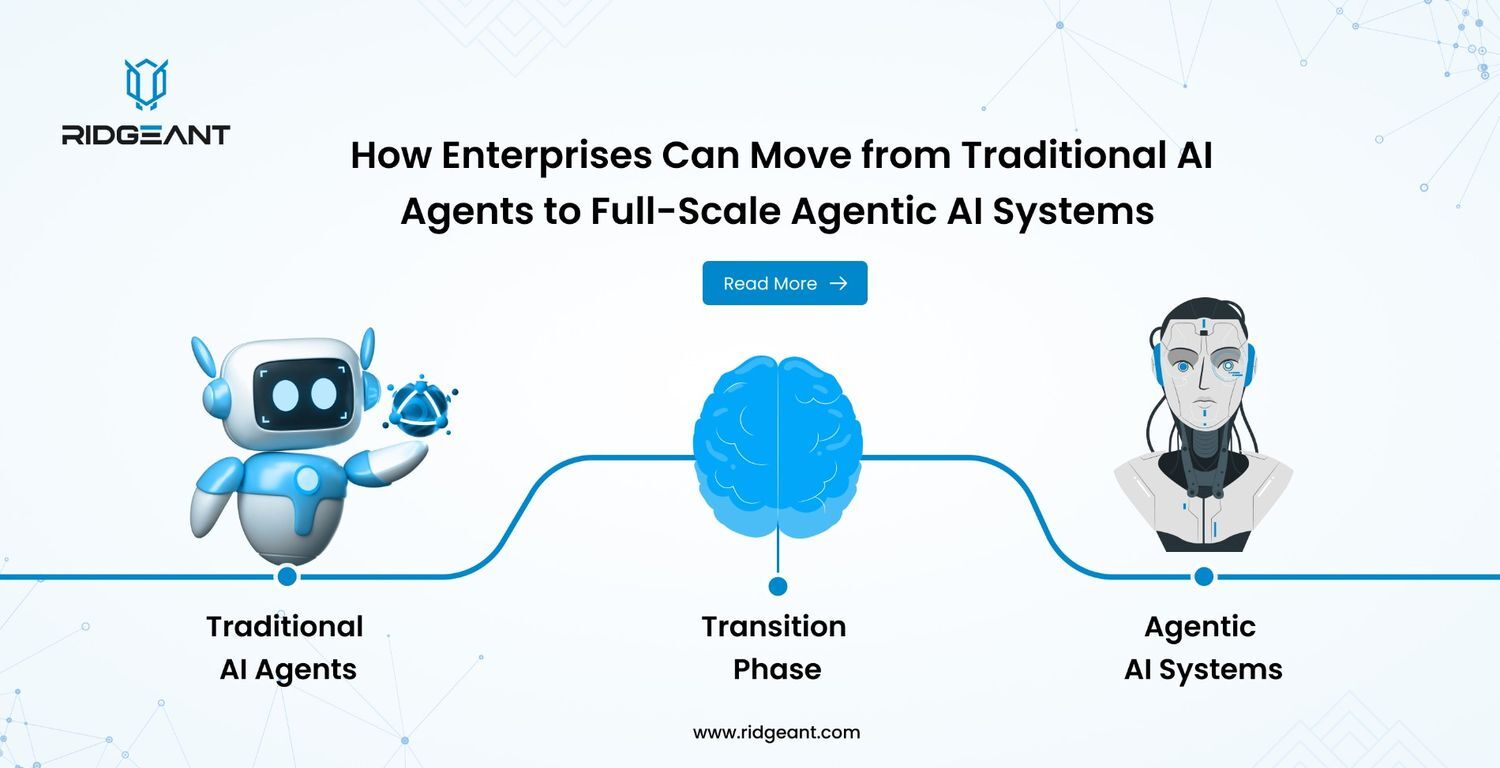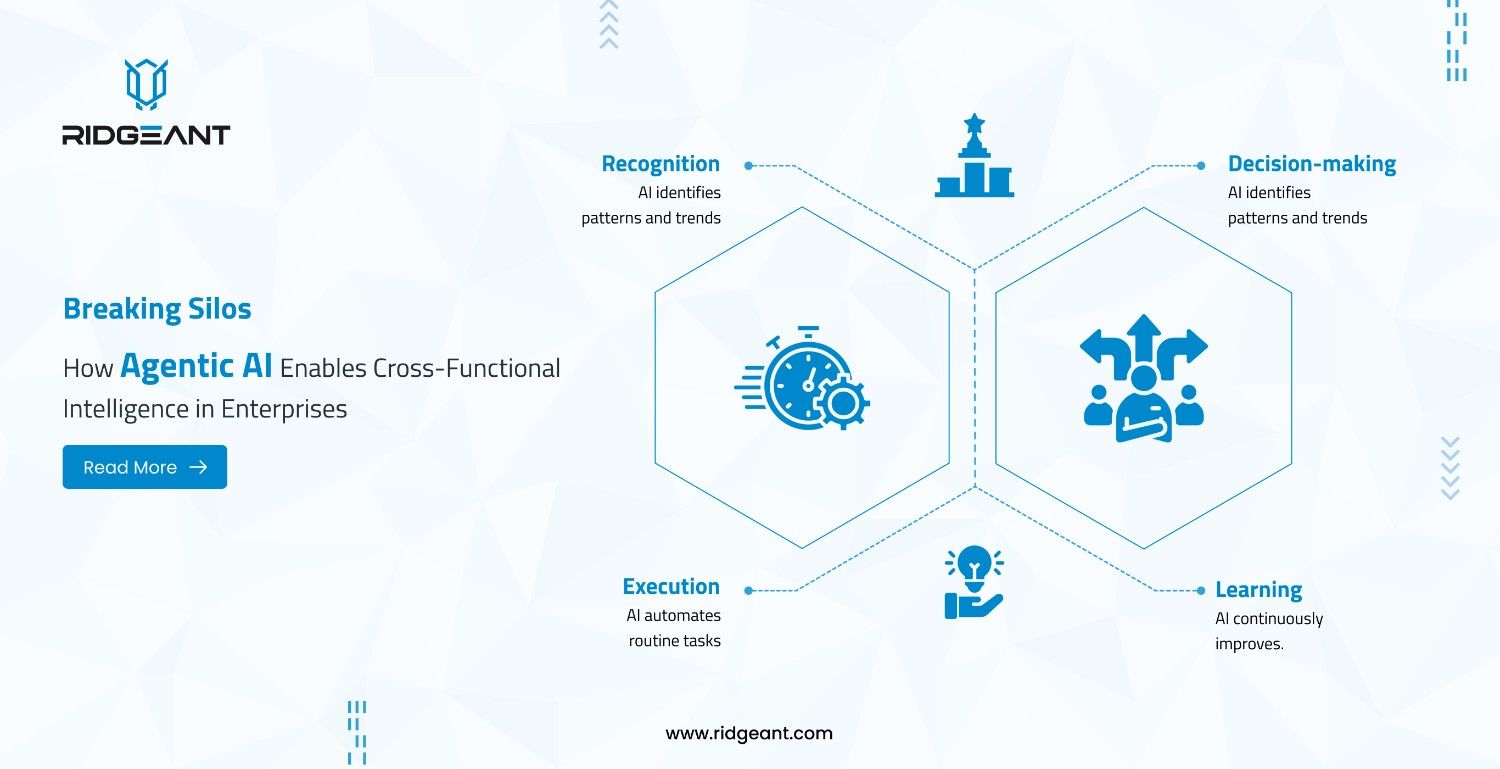
AI Agents vs. Agentic AI: Understanding the Key Differences and Business Impact
- Data Engineering, Databases, DataOps, Data Science
- January 22, 2025
- Ridgeant

The artificial intelligence market is evolving at an unprecedented rate. The global intelligent virtual agent (IVA) market was valued at approximately $4.3 billion in 2023 and is projected to grow to $16.6 billion by 2028. Enterprises are rapidly adopting AI-driven automation, with 67% of companies using AI agents for customer service by early 2024. But as AI advances, a fundamental distinction is emerging: AI Agents vs. Agentic AI.
Understanding AI Agents
AI agents are designed to handle specific tasks with a structured workflow. Their operational framework consists of:
- Input Handling: Receiving structured or unstructured data.
- Process Execution: Performing predefined actions.
- Output Generation: Delivering results based on the executed process.
- Sequential Workflow: Handling tasks step-by-step without deviation.
- Task-Specific Operation: Operating within predefined parameters.
Example Use Cases of AI Agents
- Customer Support Chatbots: Handling FAQ responses and routing inquiries.
- Personal Assistants (e.g., Siri, Alexa): Responding to user commands.
- Automated Trading Systems: Executing stock trades based on preset conditions.
- Robotic Process Automation (RPA): Automating repetitive back-office tasks.
AI agents are widely used in enterprise environments to reduce operational costs and enhance efficiency. Businesses report an average 30% reduction in customer service costs after implementing AI-driven solutions.
Understanding Agentic AI
Agentic AI operates on a different paradigm—networked intelligence. Unlike isolated AI agents, Agentic AI functions through interconnected systems, leveraging memory, analytics, and collective intelligence. Key capabilities include:
- Network Connectivity: Aggregating data from multiple sources.
- Memory & Analysis Integration: Storing and learning from historical interactions.
- Coordinated Decision-Making: Executing optimized decisions based on real-time data.
- Optimization Processes: Continuously improving efficiency and accuracy.
- Swarm Execution: Deploying AI components in tandem to achieve emergent solutions.
Example Use Cases Agentic AI
- Autonomous Vehicles: Sharing real-time traffic data across a network to optimize navigation.
- Fraud Detection in Finance: Analyzing millions of transactions dynamically.
- Healthcare AI Systems: Coordinating diagnosis across multiple hospitals using shared patient history.
- AI-Driven Cybersecurity: Detecting and mitigating threats collaboratively across a global network.
AI Agents vs. Agentic AI: Why This Distinction Matters
Traditional AI agents execute defined tasks within set boundaries. Agentic AI, however, creates solutions dynamically by analyzing complex networks of information. The real impact is seen in the shift from single-path processing to network-driven intelligence.
Market Growth and Enterprise Adoption
The adoption of AI-driven automation is accelerating, with 85% of customer interactions expected to be handled without human agents by 2025. Businesses leveraging AI agents report:
- A 35% increase in customer satisfaction scores.
- A 45% reduction in query resolution times.
- An average ROI of 250% within the first year of implementation.
Investment in Agentic AI research increased by 150% between 2022 and 2024, with over 1,200 research papers published on the topic in 2023. Major technology companies have increased R&D spending in this domain by 80% year-over-year.
Performance Metrics and Business Impact
AI Agent Performance
- Accuracy: AI agents achieve a 95% accuracy rate in task execution.
- Speed: Average response times are 0.1 seconds, significantly outperforming human agents (2.5 minutes).
- Efficiency: AI-driven automation reduces customer service costs by 30%.
Agentic AI Performance
- Scalability: Agentic AI enables real-time optimization across networks.
- Adaptability: Capable of reconfiguring workflows dynamically based on external data.
- Decision-Making: Achieves higher precision by analyzing multiple interconnected data points simultaneously.
Workforce and Business Transformation
AI-driven automation is reshaping the workforce, with 23% of companies restructuring their workforce to integrate AI solutions. Additionally:
- 45% of employees report working alongside AI agents in some capacity.
- Training time for new employees has decreased by 40% when AI-driven onboarding is implemented.
Challenges and Limitations
Despite the advantages, both AI agents and agentic AI have challenges:
AI Agents
- Limited Learning: AI agents do not retain memory and cannot adapt over time.
- Task Restriction: They are designed for specific workflows and cannot operate outside predefined rules.
- Scalability Issues: AI agents function in isolation, making it difficult to scale across interconnected processes.
Agentic AI
- High Computational Cost: Requires significant processing power and infrastructure.
- Data Privacy Risks: Since agentic AI relies on shared data, it raises concerns regarding sensitive information security.
- Complex Implementation: Requires integration with multiple systems, making deployment more resource-intensive.
Implementation Strategies for Businesses
When to Use AI Agents
- For task automation: Automating repetitive workflows like customer support.
- For cost reduction: Deploying AI chatbots to minimize human intervention.
- For structured processes: Automating rule-based workflows in finance and HR.
When to Use Agentic AI
- For real-time decision-making: Optimizing logistics and predictive maintenance.
- For interconnected systems: Enabling communication between multiple AI entities.
- For high-level optimization: Improving efficiency across supply chain networks.
Future Trends in AI Agents and Agentic AI
- Enhanced Personalization: AI will evolve to offer more customized solutions through real-time adaptation.
- AI-Augmented Workforces: More organizations will integrate AI-driven decision-making into daily operations.
- Ethical AI Development: More regulatory frameworks will emerge to address AI ethics and bias concerns.
- Expansion in IoT & Edge AI: Agentic AI will be used in real-time edge computing applications.
Choosing Between AI Agents and Agentic AI
Organizations must assess their needs based on the following factors:
- Operational Scope: AI agents are ideal for task-specific automation, while Agentic AI enables real-time adaptability.
- Scalability: AI agents function independently, whereas Agentic AI operates through interconnected networks.
- Optimization Goals: If continuous process improvement is required, Agentic AI is the better choice.
Implementing AI Solutions for Your Business
As an AI services and solutions provider, we help businesses navigate the complexities of AI adoption. Whether you’re looking for AI-powered automation, predictive analytics, or real-time decision-making solutions, our team offers expertise tailored to your industry.
Get a consultation to explore how AI can transform your business. Reach out today and take the next step toward intelligent automation!













